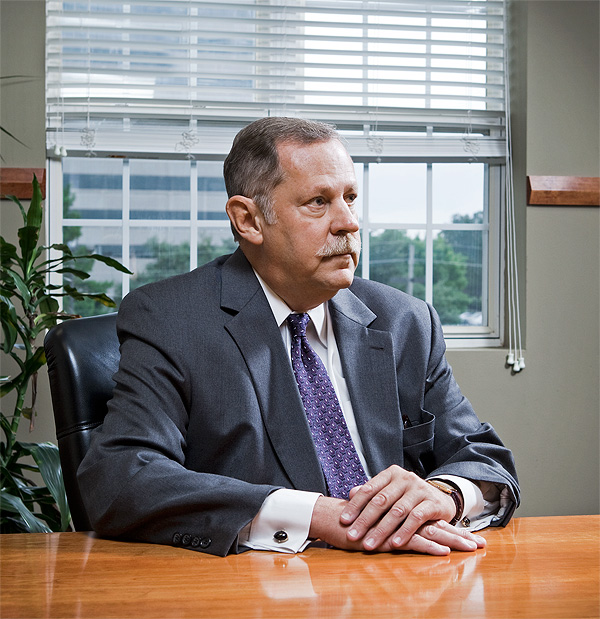Wes Jurey, president and CEO of the Arlington Chamber of Commerce, is at the cutting edge of technology. But not in the sense that he’s designing the next great mobile device or challenging Internet economics.
During the last several years, Jurey has become one of the key figures in a nationwide movement to find ways to help U.S. federal labs get the technologies they discover and perfect into the commercial market. By extension he has made Arlington, Texas—not Arlington, Virginia—the center of a web that connects hundreds of the country’s federal labs, universities, and corporations.
The project Jurey is running is called TechComm. It was launched in 2010 as Technology, Commercialization and Manufacturing, a network of networks that’s jointly operated by the Arlington Chamber of Commerce and the University of Texas at Arlington. In a way, TechComm is the culmination of Jurey’s drive to make North Texas more competitive in a high-tech world.
Jurey came to Arlington in 2001 by way of El Paso, where during his 11-year run as head of that city’s chamber of commerce, he brought it back from the brink of bankruptcy and grew its annual budget to around $10 million.
The El Paso Chamber had annual revenue of about $12 million with fewer than 2,000 members when Jurey packed his bags and headed to North Texas. By comparison, the Arlington Chamber of Commerce also had about 2,000 members, but its revenue was in the ballpark of $2.5 million.
Considering the number of universities nearby and the relatively large high-tech work force, North Texas had room to grow, but it also had some issues, Jurey says. It wasn’t a “high-tech region culturally,” he explains. “It didn’t foster deal flow, or link it to venture capital and entrepreneurs [who could] take ideas to market.”
Jurey aimed to change that.
In 2001, about a month before he began his new gig at the Arlington Chamber, Jurey told the Fort Worth Star-Telegram that he had put a “short-term, hard-hitting strategy” in front of the chamber’s board. “Not many cities have a blank canvas on which to paint a picture,” he said. “The question is where it wants to be in 10 years, 15 years, and 20 years.”
The answers to some of those questions have already been answered. Last year, Arlington grew out of its second-city status and became the only city ever to host the NBA All-Star Game, the Super Bowl, and the World Series in a 12-month span. Those aren’t technology-related events, but they fit right in with the size and scale of Jurey’s economic development ambitions for TechComm.
The idea for TechComm came from discussions at a local, somewhat obscure event. In 2004, the Arlington Chamber of Commerce secured the right to annually host a trade fair called the World’s Best Technologies Innovation Marketplace. The show had an American Idol-type component to it: Fledgling entrepreneurs would present their technologies to venture investors and federal agencies in the hope of getting funding, research agreements, or licensing deals that would get their products out of garages and onto store shelves.
The 2004 event raised more than $49 million in first round venture capital or secured licensing agreements. Jurey wondered, what would happen if you could connect federal labs, corporations, and entrepreneurs with one another’s ideas more often than just once a year?
By 2007, Jurey had guided the chamber to become self-sufficient, with its corporate members funding its activities. The nonprofit no longer needed funding from the city of Arlington, and the pressure to localize economic development was lifted. “If you’re trying to justify to city taxpayers the use of their dollars, how do you possibly explain working regionally and nationally to them?” Jurey says.
That year, Jurey was also advocating the need for a catalyst to speed up the transfer of new technologies from labs to companies in order to create jobs. “If you’re going to win in this new world, you’re going to have to collaborate,” Jurey told the Star-Telegram in 2007.
In March 2009, Jurey met with Cynthia Gonsalves, the Defense Department’s director of technology transition at the WBT Innovation Marketplace show in Arlington. Gonsalves was looking to find a way for federal agencies to get their technologies licensed and discover sources for research that they need. Jurey says he and his team went to work talking to corporations, universities, and other potential stakeholders about a network that could speed up federal technology transfer, while helping corporations get their patented technologies into federal agencies and universities.

Brenner explains that although the DoD tech transfer office is a procurement agency for the Defense Department and government markets, the USDA’s ARS was at the opposite end of the scale. “Everything that we do is ultimately for the public,” he says, noting that the agency’s objectives include developing better pesticides, improving the quality of agricultural products, and sustaining soil and natural resources.
“These are essential basics in life,” he says. “In any development of technology that we do, we want to keep the lowest transaction costs possible, so we’re not jacking up the price of food and everything else.”
Patent Pipeline
Knowing that working with each state individually would be overwhelming, Gonsalves and Brenner had both begun signing up partner intermediaries—groups that worked on regional economic development. These groups could work with one another and the federal labs to help commercialize new technologies.
“The one common member to both networks was Wes Jurey,” says Brenner. “It’s hard to find anyone with more enthusiasm for this, and he really articulates that we can’t be territorial.”
In March 2010, about 600 people attended the WBT show, which had grown to have 90 participating companies, 140 venture investors and Fortune 1000 licensees, along with eight federal agencies. At that show, Jurey pitched the idea of TechComm to Gonsalves. By July 2010, TechComm was born, thanks to a $2.5 million contract from the Department of Defense.
TechComm aims to develop partnerships in an eight-state region among universities, venture capitalists, corporations, and federal labs. That may mean helping a company in Kansas City, for example, quickly find and license the technology it needs, whether it was discovered in the UTA’s nanotech labs or at the Army’s telemedicine research center in Denver.
It may sound easy—patent data from the federal labs is public information—but the reality screams for an organized approach.
“The DoD alone has 120 labs and each lab has multiple directorates,” Jurey says. “Each directorate within a lab has multiple research missions. Within those missions are multiple researchers, patent attorneys, and staff. If you can find the right person and get them to return your call, you can, in fact, make these contacts yourself.”
Brenner at the USDA says it’s frustrating for those in the private sector to try to learn what’s available. “Web pages are great, but who can go through 450 web pages from a single federal agency?” he says.
That degree of difficulty is also why TechComm is charging corporate members a flat fee of $25,000 a year to join its network. By supporting TechComm, companies can avail themselves of a patent pipeline, while Jurey’s team looks for possible licensees for their technologies.
Jurey sees a future where TechComm will operate independently of federal funding, all while adding to the value of its network.
“Now we have the true capacity to develop deal flow from 363 federal labs that are spending a combined $100 billion a year on research and that currently have over 15,000 patents,” Jurey says.
Indeed, with the DoD’s backing, TechComm now also serves as a partner intermediary to the U.S. Department of Homeland Security, the U.S. Department of Transportation, and the National Institutes of Health. Additional federal agency agreements are pending.
A TechComm web portal—giving agencies, universities, and partner companies like Lockheed Martin a common front door to the TechComm network—is in the works, says Ben Macgill, director of development at the Center for Innovation in Arlington. As described in TechComm’s charter, the site will include “extensive search capability among and between the partners, supporting the process of technology transfer activities from beginning to end, to include transition of the final product to the marketplace.”
TechComm has access to the patents at national federal labs of several different agencies, but its near-term scope is to work with universities, companies, and other economic development organizations in the eight-state area: Texas, Arkansas, Colorado, Kansas, Oklahoma, Louisiana, New Mexico, and Missouri. The model will scale to become the first nationwide innovation network, Jurey says.
Because the project is only about a year removed from being a pile of PowerPoint slides, it’s tough to measure the success of TechComm. But Jurey is confident that “in the longer term, it will create technology startups and expand and enhance existing technology companies.” In the short term, there are only two questions Jurey’s concerned about: “First, do we in fact get these technologies out of the labs and into
commercial production? Secondly, do we create jobs and wealth?”
“The role [Jurey] is playing here is a big one,” Brenner says. “We have a huge opportunity to fast-track commercialization here, whether it be for the DoD or for consumers.”
Other companies exist that can help pair entrepreneurs with federal patents and vice versa, but they usually require fees for every service they provide. “The vested interest for Wes and groups like TechComm is job creation,” says Brenner. “That’s it.”
Phil Harvey is editor-in-chief of Light Reading, a UBM TechWeb publication covering the telecom industry.







